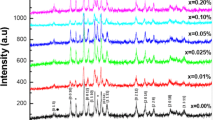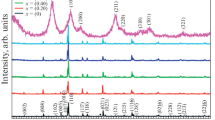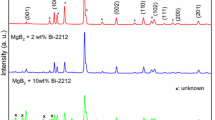Abstract
Mechanical behavior of YBa2Cu3O7−x (Y123) superconductors exposed to Sn nanoparticles diffusion is determined by the way of Vickers microhardness (H v ) conducted at different applied loads (0.245N≤F≤2.940 N). Load dependent microhardness, load independent microhardness, elastic modulus, and yield strength values are estimated from the microhardness curves. Unpredictably, the findings of the H v values reveal that the undiffused sample and Sn diffused sample prepared at 500 ∘C exhibit reverse indentation size effect (RISE) behavior while the other samples obey indentation size effect (ISE) nature. Further, we extract the load independent (true) microhardness using the Meyer’s law, proportional specimen resistance (PSR), elastic/plastic deformation (EPD), Hays–Kendall (HK) approach and indentation-induced cracking (IIC) model, and compare the true hardness with the apparent hardness.
Similar content being viewed by others
Avoid common mistakes on your manuscript.
1 Introduction
The mechanical characteristics of the Y1Ba2Cu3O7−x (abbreviated as Y-123) superconducting materials as well as the electrical and superconducting properties play important role on the potential applications in engineering and industry, and can be determined from the hardness measurements. As is well known, the hardness is to measure the resistance of a material as a function of the applied indentation test load on the specimen surface [1–4]. Additionally, the hardness measurements are nondestructive and performed easily [5]. In literature, there are several methods about how to measure the hardness belonging to a solid material. Especially, Brinell, Rockwell, and Vickers hardness tests are superior to the other measurement methods due to both an easier control mechanism on the quality level of products [6] and faster description of the plastic deformation from a standard source. Among the methods, the Vickers hardness test developed in 1921 by Smith et al. obtains the widest scales owing to the useful for the determination of the hardness of all the metals [7]. At the same time, independence of the indenter size on the calculations such as Young modulus, brittle index, fracture toughness, ductility, impact, yield strength, and tensile strength parameters is another attractive property. However, the Vickers test is only performed accurately on polished surfaces. Hence, it can be disadvantage that the Vickers test is inadequate to provide accurate results on the rough surfaces. In the present work, we try to explain the change of the mechanical properties of the Y-123 superconductors by both the Sn inclusions and diffusion annealing temperature. Moreover, the independent (real) hardness values are theoretically analyzed by the available approaches.
2 Experimental Details
In previous work [8], we analyzed the superconducting and microstructure properties of YBa2Cu3O7−x samples by standard experimental methods such as dc electrical resistivity, X-ray diffraction analysis, electron dispersive X-ray, scanning electron microscopy, transport critical current density measurements. The samples prepared in [8] are used for the aim of this work. In this study, the influence of Sn inclusions in Y123 core on mechanical properties is examined by way of microhardness measurements using a SHIMADZU HVM-2 model digital microhardness tester (300 K). The indentation test load is applied for the duration of 10 s in the load range from 0.245 N to 2.940 N. In this work, the undiffused sample is displayed as Sn0 whereas the superconductor samples produced with different annealing temperature such as 500, 600, 700, 800, 900, and 945 ∘C will be herein after denoted as Sn1, Sn2, Sn3, Sn4, Sn5, and Sn6, respectively.
3 Results and Discussion
3.1 Microhardness and Modeling
The load dependent microhardness (H v ) values of various applied loads from 0.245 N to 2.940 N can be extracted from the formula:
here (d) is our experimentally measured indentation diagonal lengths at different applied loads (F) are visualized in Table 1. It is visible from the table that the H v values for all the samples depend strongly on the applied loads and diffusion annealing temperature. The variation of the H v with regard to the applied loads, on the surfaces of the pure and Sn1 samples is exhibited in Fig. 1a. It is apparent from the figure that the microhardness values of the samples enhance with the increasing applied load for Sn0 and Sn1 samples, which is known as RISE (reverse indentation size effect) [9–11]. This may be related to the fact that the RISE feature can be the improvement strength of connection between superconducting grains. The Sn2, Sn3, Sn4, Sn5, and Sn6 samples demonstrate the ISE behavior being attributed to the fact that the load dependent hardness values descends nonlinearly as the applied load increases up to 2.0 N after this point the curves shift to the plateau region (Fig. 1b). The change in the curves is because of the grain boundary weak-links, specimen cracking/porosity, disorder, impurity phases, and irregular grain orientation distribution [12–14].
Further, the Young’s (elastic) modulus (E) and yield strength (Y) can be evaluated from the equations:
The results calculated are presented in Table 1. As can be seen from the table, elastic modulus and yield strength values are found to ascend (reduce) with the applied load for the samples showing the RISE (ISE) nature. Besides, Meyer’s law, PSR, EPD, HK approach, and IIC model are used to calculate the load independent microhardness values and the RISE and ISE natures of the Y123 superconducting samples studied are explained in detail.
3.1.1 Meyer’s Law
This law is one of the most useful methods to define the mechanical performances of the superconducting matrix and the formula recognized:
where the power n presents the Meyer number and A 1 is the standard microhardness constants. Figure 2 shows the plots of lnF versus lnd for all the samples. The n and A 1 values deduced from the curves are reported in Table 2. The n value predicts us to verify the ISE and RISE behavior. It is obvious from the table that the Meyer’s number values are obtained to be greater than 2 for Sn0 and Sn1 samples, indicating the RISE feature. Further, n values is found to be <2 for Sn2, Sn3, Sn4, Sn5, and Sn6 samples because of ISE nature [15, 16].
3.1.2 PSR Model
PSR model playing a significant effect in understanding the mechanical properties of a superconducting system is identified by the equation:
where the α is the surface energy. Change in α value is associated with the energy dispersion of the surface cracks. Furthermore, the α and β values can be deduced from the linear graphs of F/d versus d (Fig. 3) and the findings are gathered in Table 2. It is clear from the table that the surface energy is negative for Sn0 and Sn1 samples, presenting RISE nature when the α is positive for the Sn2, Sn3, Sn4, Sn5, and Sn6 samples showing ISE feature, presenting that the plastic deformation is superior to the elastic deformation in the samples. Moreover, the β values permit us to estimate the load independent microhardness via equation:
The calculated H PSR values are embedded in Table 3. Moreover, the H PSR values enhance with the increment in the diffusion annealing temperature up to Sn2 beyond which these values start to increase; in fact, the Sn6 sample has the maximum values. As seen from the table, the PSR model is not useful for the explanation of the real microhardness value of the undiffused and Sn inclusions inserted in the Y123 crystal structure.
3.1.3 EPD Model
A material reporting the mechanical behavior can easily be studied by the elastic/ plastic deformation (EPD) model. In this model, the dependence of indentation size on the applied load is defined by the following equation [17]:
where A 2 is the load independent microhardness constant and the elastic deformation (d e ) is related to (d p ) plastic deformation. Figure 4 illustrates the linear graphs of F 1/2 versus d p for the Y123 superconductors samples. The values of A 2 and d e are gathered in Table 2. According to findings, the found d e values are obtained to be negative for the Sn0 and Sn1 samples in consequence of the dominant character of the plastic deformation in the material, illustrating the RISE behavior. However, the values are found to be positive for the other samples because of the ISE behavior. Besides, the load independent microhardness value can be described by formula:
The computed results are given in Table 3. The H EPD value of the samples gradually decreases from 4.174 GPa to 0.985 GPa with the enhancement in the diffusion annealing temperature up to 700 ∘C (Sn2) beyond which the H EPD values start to enhance systematically to a local maximum (2.471 GPa) for the Sn6 sample. It is to be mentioned here that the EPD model is not a adequate define for the determination of the real microhardness values belonging to all the Y123 superconductors produced in this work.
3.1.4 HK Approach
The HK approach is one of the convenient approaches to find the microhardness characteristics of a substance. In the HK approach, the existence of the plastic deformation as well as the elastic deformation can be observed while the material is subjected to the certain limit of test load (W). In other words, the indenter does not enter into the superconducting material up to a certain value of applied load beyond which the indentation size starts to increase abruptly [18, 19]. Thus, the irreversible (plastic) deformation starts to play a much more dominant role than the reversible (elastic) deformation because of the absence of the elastic recovery in the material. To sum up, the dependence of the indentation size on an effective load F eff=F−W is much more than the applied load (F), and so the size is determined by use of the following relation:
where A 3 denotes the microhardness constant. For the Y123 samples, Table 2 displays the A 3 and W values estimated from linear F–d 2 as shown in Fig. 5. It is evident from the table that the values of W are negative for the Sn0 and Sn1 samples reporting RISE nature. This may be attributed to the fact that applied load is adequate to produce both the elastic and plastic deformation. On the other hand, the positive W parameters obtained for Sn2, Sn3, Sn4, Sn5, and Sn6 samples, showing that the applied load is not enough to generate the plastic deformation. Further, the H HK can be computed by use of the following equation:
The obtained values of H HK values are listed in Table 3. Based on findings, the H HK values regularly descend with ascending the diffusion annealing temperature up to 700 ∘C after which it increase slowly; in fact, the maximum values (1.585 GPa) are obtained for the Sn6 sample. It is interesting point from the table that the HK approach is completely successful for the explanation of the ISE nature for the Sn2, Sn3, Sn4, Sn5, and Sn6 samples. On the other hand, the HK approach is not an adequate definition for the determination of the real microhardness values for Sn0 and Sn1 superconducting samples because of illustrating the RISE feature.
3.1.5 IIC Model
In the IIC model, the load independent microhardness values (H IIC) can be determined by the following relation:
The constant values of K and m are summarized in Table 2. Further, Fig. 6 shows the dependence of lnH v on ln(F 5/3/d 3) for the undiffused and Sn diffused Y123 system. According to the table, the m values are found to be <0.6 for the Sn0 and Sn1 samples due to the RISE behavior; whereas that of the Sn2, Sn3, Sn4, Sn5, and Sn6 samples is obtained to be >0.6, indicating the ISE feature of the samples [18]. This is one of the most striking results of the study. Based on the results, the IIC model is very successful to define the microhardness characteristics of the Sn0 and Sn samples showing RISE nature. Table 3 also confirms that the load independent microhardness value of the IIC model is very close to the load dependent microhardness values (plateau region) for the Sn0 and Sn1 samples. The suitability of the IIC model may stem from two main reasons: (I) the sample obtains no elastic recovery and (II) the irreversible deformation in the crystals is more dominant as compared to the reversible deformation [20]. Hence, it is not wrong to say that the pure Y123 sample is perfectly brittle.
4 Conclusions
From the findings depicted above, the following conclusions can be drawn:
-
The Vickers microhardness, elastic modulus, and yield strength values decrease with the enhancement of the diffusion annealing temperature up to 700 ∘C beyond, which they start to increase due to the decrement in the strength of the bonds between the superconducting grains.
-
Meyer’s law, PSR, EPD, and HK approaches are found to be not enough to explain the mechanical properties of the Sn0 and Sn1 samples presenting the RISE feature.
-
The IIC model is observed to be the best model to understand the load independent (true) microhardness values for the Sn0 and Sn1 samples.
-
The HK approach is obtained to be the most successful model to describe the mechanical properties of the Sn diffused Y123 superconductors (Sn2, Sn3, Sn4, Sn5, and Sn6 samples) showing the ISE behavior.
References
Yoshino, Y., Iwabuchi, A., Onodera, R., Chiba, A., Katagiri, K., Shimizu, T.: Cryogenics 41, 505–511 (2001)
Uzun, O., Kolemen, U., Celebi, S., Guclu, N.: J. Eur. Ceram. Soc. 25, 969–977 (2005)
Uzun, O., Karaaslan, T., Keskin, M.: J. Alloys Compd. 358, 104–111 (2003)
Dogruer, M., Zalaoglu, Y., Gorur, O., Ozturk, O., Yildirim, G., Varilci, A., Yucel, E., Terzioglu, C.: J. Mater. Sci., Mater. Electron. 24, 776–783 (2013)
Cavdar, S., Deniz, E., Koralay, H., Ozturk, O., Erdem, M., Gunen, A.: J. Supercond. Nov. Magn. 25, 2297–2307 (2012)
Kakani, S.L., Kakani, A.: Material Science, 1st edn. New Age International, New Delhi (2004)
Smith, R.L., Sandland, G.E.: An accurate method of determining the hardness of metals, with particular reference to those of a high degree of hardness. In: Proceedings of the Institution of Mechanical Engineers (1922)
Gorur, O., Ozturk, Y., Yildirim, G., Dogruer, M., Terzioglu, C.: J. Mater. Sci., Mater. Electron. (2013). doi:10.1007/s10854-013-1212-4
Dogruer, M., Karaboga, F., Yildirim, G., Terzioglu, C.: J. Mater. Sci., Mater. Electron. 24, 2327–2338 (2013)
Awad, R., Abou Aly, A.I., Kamal, M., Anas, M.: J. Supercond. Nov. Magn. 24, 1947–1956 (2011)
Sangwal, K.: Mater. Chem. Phys. 63, 145–152 (2000)
Ling, H.C., Yan, M.F.: J. Appl. Phys. 64, 1307–1311 (1988)
Asikuzun, E., Ozturk, O., Cetinkara, H.A., Yildirim, G., Varilci, A., Yilmazlar, M., Terzioglu, C.: J. Mater. Sci., Mater. Electron. 23, 1001–1010 (2012)
Dogruer, M., Gorur, O., Karaboga, F., Yildirim, G., Terzioglu, C.: Powder Technol. 246, 553–560 (2013)
Quınn, J.B., Quınn, V.D.: J. Mater. Sci. 32, 4331–4346 (1997)
Dogruer, M., Karaboga, F., Yildirim, G., Terzioglu, C., Ozturk, O.: J. Mater. Sci., Mater. Electron. (2013). doi:10.1007/s10854-013-1152-z
Bull, S.J., Page, T.F., Yoffe, P.E.H.: Mag. Lett. 59, 281–288 (1989)
Hays, C., Kendall, E.G.: Metallurgy 6, 275–282 (1973)
Gane, N., Bowden, F.P.: J. Appl. Phys. 39, 1432–1435 (1968)
Sangwal, K.: Mater. Chem. Phys. 63, 145–152 (2000)
Author information
Authors and Affiliations
Corresponding author
Rights and permissions
About this article
Cite this article
Doğruer, M., Terzioğlu, C., Yildirim, G. et al. Significant Change in Mechanical Properties of YBa2Cu3O7−x Bulk Superconductors Diffused with Sn Nanoparticles. J Supercond Nov Magn 27, 755–761 (2014). https://doi.org/10.1007/s10948-013-2379-x
Received:
Accepted:
Published:
Issue Date:
DOI: https://doi.org/10.1007/s10948-013-2379-x










